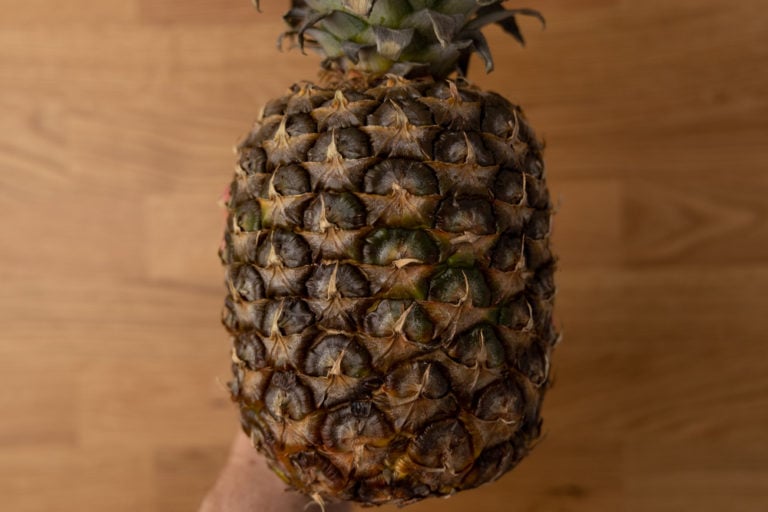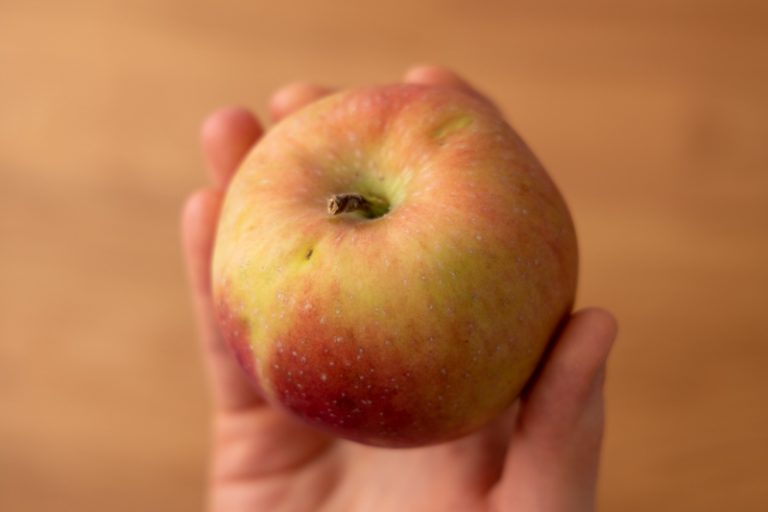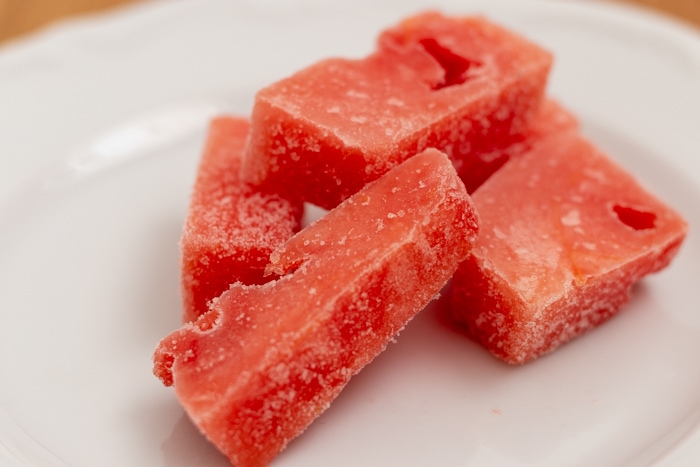How to Store a Banana to Keep It Fresh Longer?
Here’s everything you need to know about storing bananas. Learn how to store unripe bananas, what to do with ripe ones, and how to go about peeled or halved bananas.
Got a big bunch of bananas that you want to keep fresh for as long as possible? Or maybe you have a leftover banana half or a peeled one and need to know how to store it for later.
If that sounds familiar, this article is for you. In it, we cover the following:
- storing unripe and ripe bananas (and how to tell if yours is ripe or not)
- options for keeping a leftover banana half or quarter
- dealing with peeled bananas and how to avoid browning
- storing dried bananas (or banana chips)
Read on.
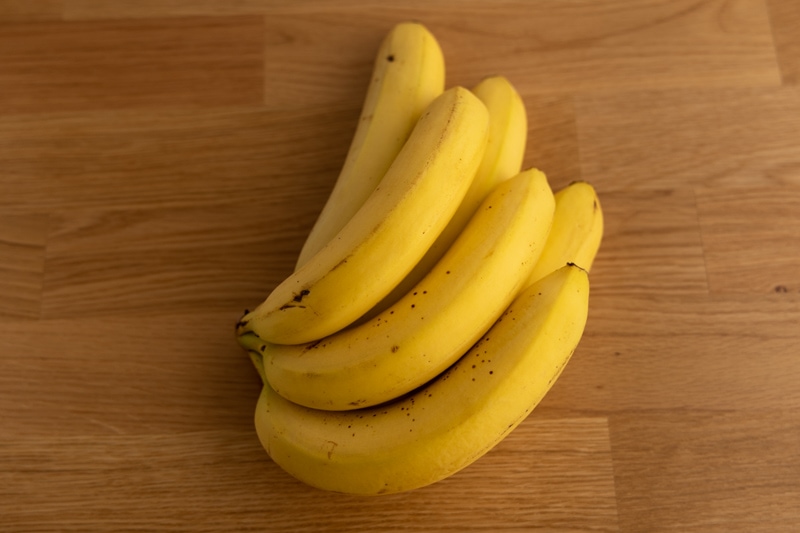
How to Store a Banana
An unripe banana should sit at room temperature until it turns yellow and ripens fully. That typically takes 1 to 5 days. Once ripe, you can leave the banana on the counter for 2 to 3 days or refrigerate it for about 7 to 10 days.
As you probably know, unripe bananas are green, turning yellow as they ripen. And while unripe bananas are edible, the difference between them and fully matured ones is huge.
As bananas ripen, their starch content is converted into sugars. That results in softening and sweetening of the banana flesh, making it the soft and sweet fruit everyone knows and loves.
Knowing that, you can decide to buy green bananas if you need them to last a long time or stick to yellow ripe ones if you need them soon. Or buy some of each kind.
Related: How long do bananas last?
Now that you know which is which, let’s talk about storage practices.
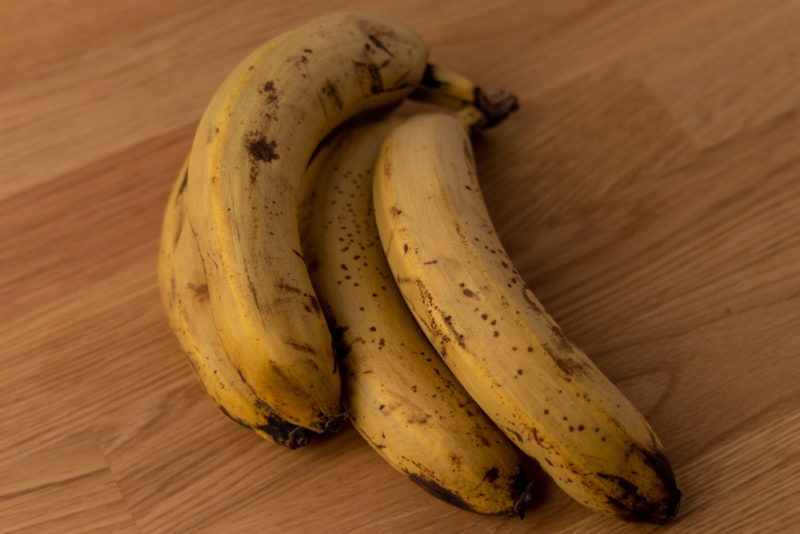
Green Unripe Bananas
Store unripe bananas at room temperature away from direct sunlight until they ripen. Don’t refrigerate unripe bananas, as that might disrupt the ripening process, which means you may end up with a firm banana that’s not that sweet, no matter how long you ripen it.
The whole ripening process typically takes between a day up to 5, maybe 7 days, depending on the color of the fruit. Green ones take much longer, while ones that are mostly yellow with some hints of green only need an extra day or two to finish ripening.
To speed up the ripening process, place the bananas in a brown bag and fold the opening. Add another ethylene-producing fruit to the mix, such as an apple or a pear, to accelerate things further.
This works because the ethylene gas that bananas produce helps them ripen, and sealing them in a bag helps trap that gas. Adding another fruit to the bag simply helps increase ethylene concentration.
(As an aside, don’t use a plastic bag if possible. That’s because it traps all the moisture, which may cause the banana to rot.)
If you want to slow down the ripening process, there’s a trick for that, too: wrap the banana stem with plastic wrap or aluminum foil.
The stem emits most of the ethylene, so when you wrap it, the gas is trapped and access to the rest of the fruit is limited, slowing down the ripening process. With this hack, you can prolong the unripe stage for an extra couple of days.
Ripe Bananas
Ripe bananas keep for 2 to 3 days on the counter and between 7 to 10 days in the fridge. While the banana peel darkens quickly when refrigerated, the flesh keeps quality for much longer.
In other words, whether or not you should refrigerate ripe bananas depends on when you plan on eating or using them.
If you’ll use them soon, leaving the bananas on the counter is fine. But if you need them to stay fresh for more than a few days, refrigeration is the better choice.
When it comes to where exactly you should place your bananas in the fridge, there are at least two options.
The first is to place it in the produce drawer, where you likely keep other fruits and veggies.
The issue with that is that even fully matured bananas produce some ethylene. It’s not nearly as much as ripening ones emit, but it’s something. And that something will speed up maturing and decay of other fruits and veggies sensitive to ethylene. Which is something we’d like to avoid, of course.
(Here’s a list of ethylene-sensitive produce if you’re looking for one.)
The other option is simply placing the banana bunch on a fridge shelf. This way, the ethylene gas it produces won’t affect other fruits and veggies, assuming you don’t put any nearby. And that’s what I recommend.
Once again, if you refrigerate bananas for more than a few days, know that their peel will turn brown and eventually black. That means those bananas will look pretty bad from the outside, but the flesh will still stay nice and white for about a week or so.
Here’s how that peel might look like after about a week:
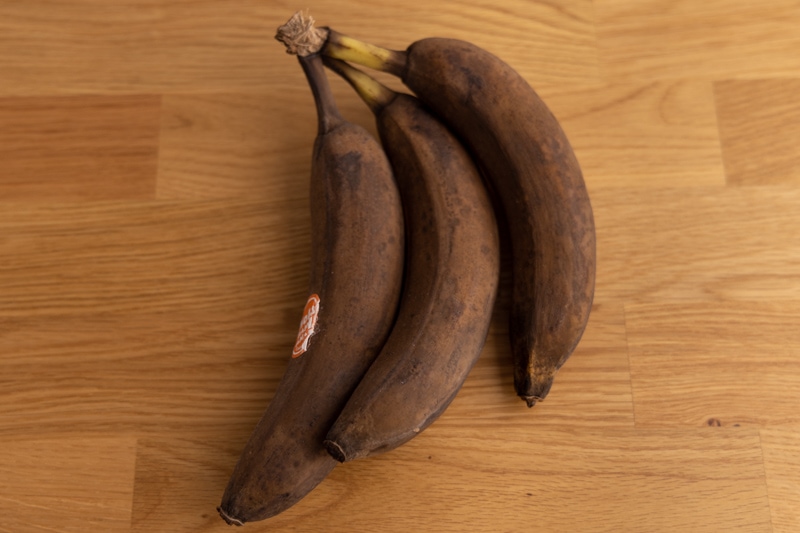
It doesn’t look that great, does it? But here’s how one of these looks inside:
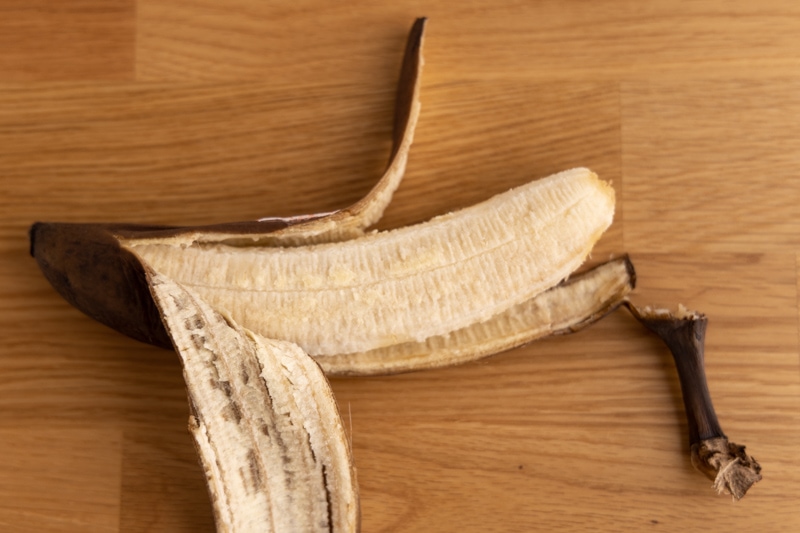
Unfortunately, you don’t quite know in advance whether that banana with black peel will be perfectly fine inside, or not.
But if the flesh turns out dark and overripe after peeling, you can still use that banana in baking. A popular option for using overripe bananas is banana bread.
Related: How Long Does Banana Bread Last?
Related: How to Store Banana Bread?
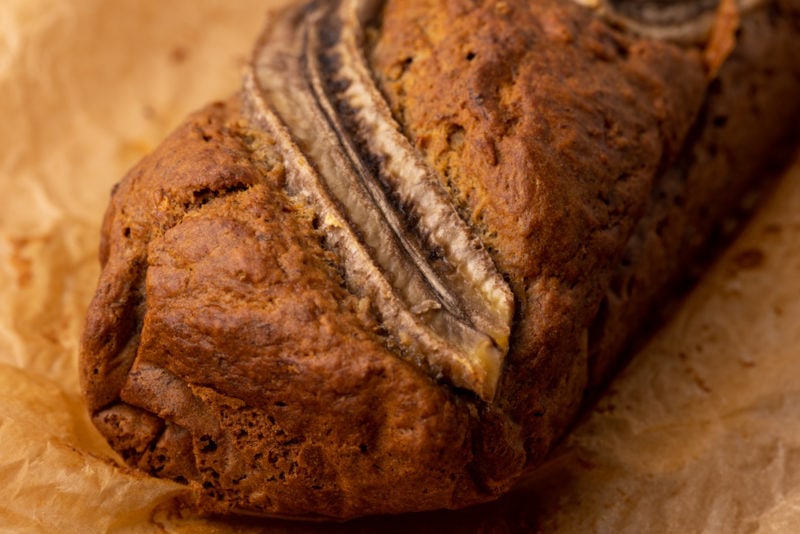
How to Store Half a Banana
Let’s say you cut your banana in half (or in quarters, or what have you), and you want to store the leftover part.
Here’s how you store a partially eaten banana:
- (Optional) Dip the cut end of the fruit in lemon juice. This will prevent it from darkening in storage. If you don’t have lemon juice available, lime juice, orange juice, or even grapefruit juice should do the trick. And if you don’t care about browning or don’t have any fruit juice on hand, feel free to skip this step.
- Cover the cut end of the banana with plastic wrap. Make sure any split part of the peel is covered too. Preventing the banana flesh from contact with the air is what we’re after here. You can use a silicone food saver (or food hugger) instead of plastic wrap, but don’t use aluminum foil if you dip the cut end in fruit juice (acid reacts with aluminum foil).
- Place the banana in the fridge for 3 to 4 days.
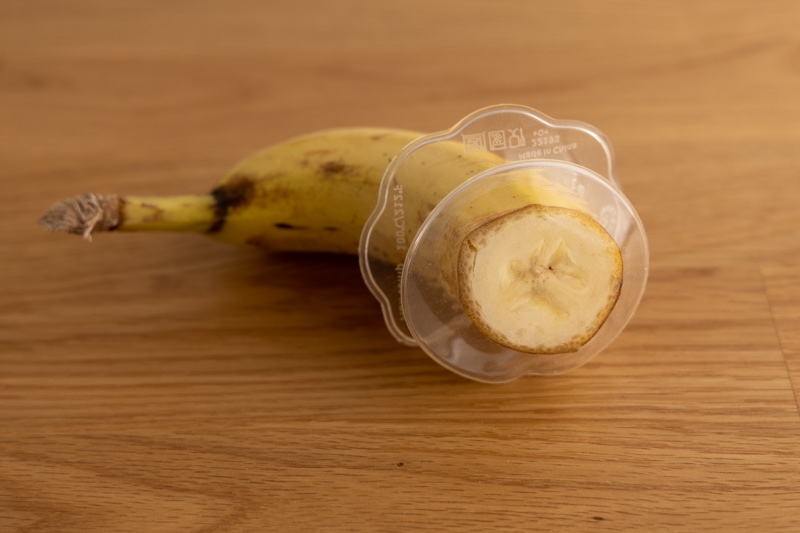
Some people recommend placing that half a banana in a freezer bag or airtight container to further protect it from the air, but I don’t think it’s necessary. You can store a whole banana as-is in the fridge, so it should keep just fine as long as the bare banana flesh is tightly covered.
Alternatively, you can place that banana half or third in a freezer bag or airtight container without covering the cut end and call it a day. Just know that the banana flesh that’s not covered will start to brown and become slime-ish in a day or so.
Now, no matter which option you go with, unless you spray the cut end with fruit juice (or another acidic solution), there will be some browning there. That’s okay and nothing to worry about; just make sure you cut off that deteriorated bit before using the rest.
Storing Peeled Bananas
Bananas keep quality much better with the peel on, so if you know you’re only going to use half of it, cut the other half off and store using the guidelines above.
But say you already peeled that banana, and you’re left with a whole or partially eaten peeled banana. Here’s how you store peeled bananas:
- (Optional) Spray the banana with lemon juice. Banana flesh tends to brown in storage, and if that bothers you, you need to cover it with something acidic, like juice from a citrus fruit such as lemon, lime, orange, or grapefruit. The way you apply the acidic solution to the banana isn’t important. It doesn’t matter whether you have an atomizer, mister, use a brush to cover the flesh, or dip the fruit in the juice.
- Place the banana in a resealable bag. Squeeze out all excess air before sealing the bag tightly. I recommend using bags specifically because there’s little air left compared to containers. And less air means less oxidation and slightly slower quality loss.
- Refrigerate for 2 to 4 days.
If you skip spraying the banana with an acidic agent, the flesh will start to brown in a day or so, especially near any cut ends.
Here’s how the beginning of flesh browning looks like:
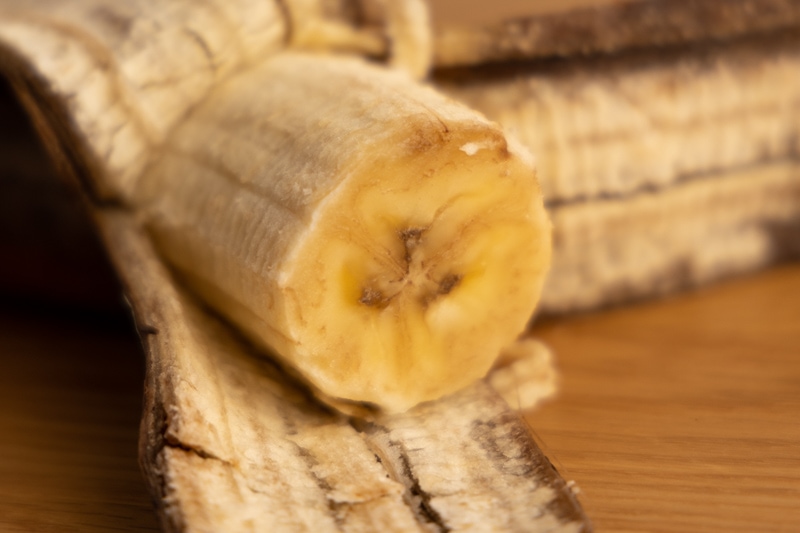
As you might imagine, you can replace the bag by wrapping the banana with plastic wrap. However, I recommend storage bags simply because they’re reusable and are a much more environment-friendly option than plastic wrap.
Last but not least, if you misted the banana with anything acidic, don’t use aluminum foil to wrap it. That’s because that foil reacts with the acidic agent, and you probably don’t want to ingest extra aluminum.
(You most likely won’t get sick if you eat a banana sprayed with citrus juice and wrapped with aluminum foil, but it’s better if you don’t do it in the first place.)
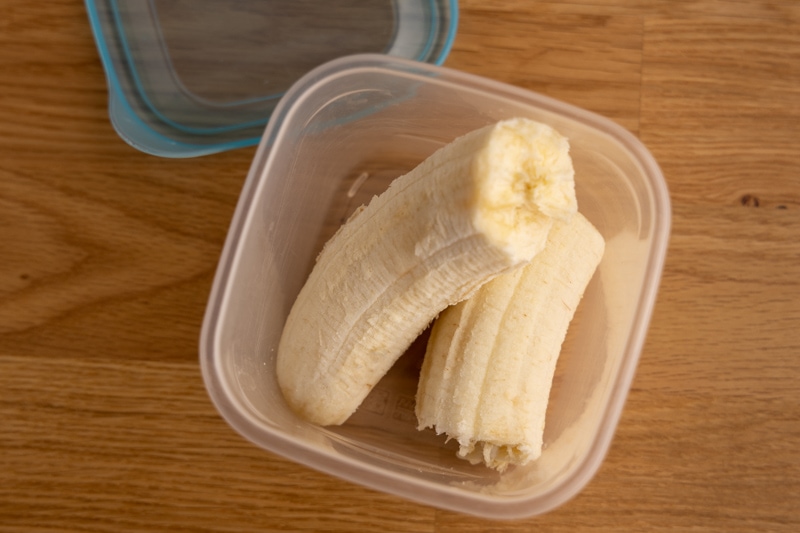
How to Store Dried Bananas
The pantry or kitchen is the best place to store dried bananas (or banana chips) – just choose a cool and dry area. They should easily last for at least a couple of weeks past the best-by date that way.
If you live in a hot and humid climate or simply want to prolong the storage time of dehydrated bananas, the fridge is a better option.
Once you open the package, seal it tight or put it in an airtight container if sealing isn’t possible.
A good seal is critical if you store dried bananas in the fridge or live in an area with high humidity. In either case, your dried good, if not sealed properly, can pick up moisture from the environment and possibly grow mold.
Rotten Records: Share Your Snap!
Caught some food past its prime? Upload your photo to “Rotten Records” and help others spot the signs of spoilage. Every image makes our food community safer and more informed!
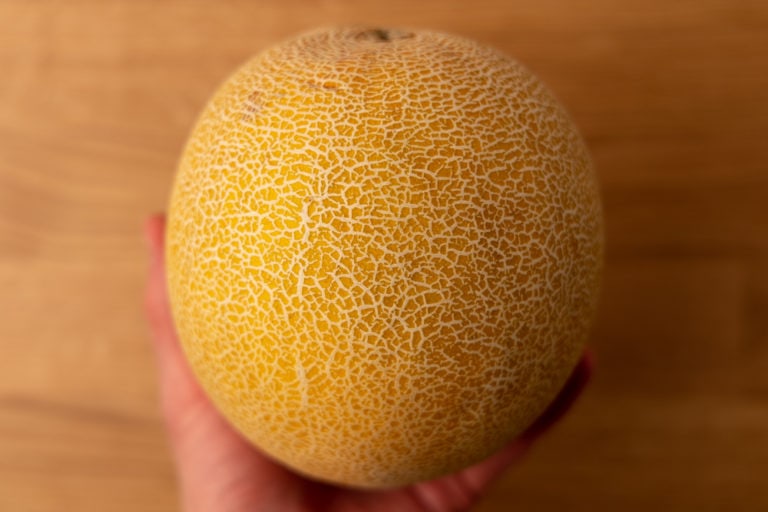
![Can You Freeze Mango? [Whole, Chunks, and Puree]](https://www.doesitgobad.com/wp-content/uploads/Frozen-mango-chunks-768x512.jpg)
